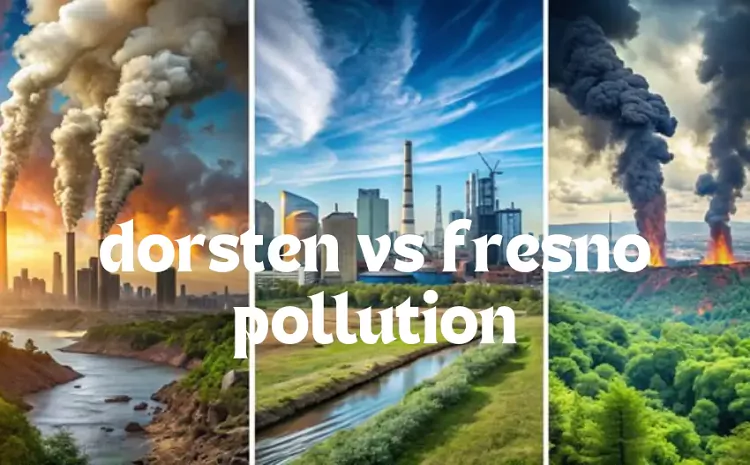Pollution is a critical global issue that affects both human health and the environment. Understanding how pollution levels differ between various regions can help us gain insights into the effectiveness of environmental policies, community involvement, and the impact of industrial activities. In this article, we’ll compare the pollution levels between Dorsten, a small town in Germany, and Fresno, a major city in California, across multiple pollution categories, including air, water, and noise pollution. Both places offer unique challenges and solutions in tackling pollution.
Overview of Dorsten and Fresno
Dorsten is located in North Rhine-Westphalia, Germany. As a smaller town with around 75,000 residents, it has a more controlled industrial base, mainly consisting of local manufacturing, agriculture, and some small-scale industries. Despite its modest size, Dorsten faces pollution challenges primarily driven by vehicular traffic and nearby industrial areas.
Fresno – A Major City in California
Fresno, on the other hand, is a large city located in California’s Central Valley. It’s a hub for agriculture and logistics, with sprawling urban development. With a population exceeding 500,000, Fresno deals with significant pollution issues, particularly due to its reliance on automobiles and intensive agricultural activities, which contribute heavily to air and water pollution.
Air Pollution in Dorsten
Air Quality Monitoring in Dorsten
Dorsten has implemented strict air quality monitoring to ensure that pollution levels are kept in check. The town utilizes real-time data from monitoring stations spread throughout the area to track the concentration of particulate matter (PM2.5 and PM10), nitrogen dioxide (NO2), and other harmful gases.
Main Contributors to Air Pollution in Dorsten
The primary sources of air pollution in Dorsten are local industries and vehicular traffic. While industrial emissions are controlled through regulations, the growing number of private vehicles contributes to the rise in NO2 and particulate matter levels, especially during peak traffic hours.
Air Pollution in Fresno
Air Quality in Fresno
Fresno’s air quality is frequently ranked as one of the worst in the United States, especially during the summer months when agricultural burning and vehicle emissions combine with high temperatures to create smog. The city’s Air Quality Index (AQI) often exceeds safe limits, posing significant health risks to residents.
Causes of Air Pollution in Fresno
Agriculture, a vital part of Fresno’s economy, is one of the biggest contributors to air pollution. The use of pesticides, dust from plowing fields, and emissions from farm machinery add to the city’s pollution levels. Vehicle emissions from Fresno’s sprawling suburbs also play a substantial role in deteriorating air quality.
Comparing the Air Quality Between Dorsten and Fresno
Common Pollutants
Both Dorsten and Fresno deal with high levels of particulate matter (PM2.5 and PM10) and nitrogen dioxide (NO2). However, Fresno’s air quality tends to be worse due to its larger population, heavier reliance on agriculture, and more intense traffic congestion.
Seasonal Variation in Air Quality
In Dorsten, air quality tends to improve during the colder months, while Fresno experiences worsening air pollution during summer due to higher temperatures and stagnant air conditions.
Water Pollution in Dorsten
Sources of Water Contamination
Water pollution in Dorsten is primarily driven by industrial waste and agricultural runoff, especially in nearby rural areas. However, strict environmental regulations ensure that pollutants like heavy metals and fertilizers are kept within permissible limits.
Efforts to Combat Water Pollution in Dorsten
The local government has invested in advanced water treatment facilities and actively monitors water bodies to prevent contamination. Public initiatives also encourage the responsible use of water resources and reduce waste.
Water Pollution in Fresno
Water Quality Issues
Fresno has long struggled with water contamination, particularly from nitrates used in fertilizers that seep into the groundwater. The overuse of fertilizers has led to unsafe levels of nitrates in drinking water, posing serious health risks to local communities.
Measures Taken to Improve Water Quality
Legislation at both the state and federal levels has been introduced to address Fresno’s water quality issues. Local authorities have also started conservation projects to restore water bodies and reduce contamination from agricultural runoff.
Noise Pollution Comparison
Noise Levels in Dorsten
Dorsten experiences moderate noise pollution, mainly due to urbanization and traffic. However, compared to larger cities, Dorsten’s noise levels remain relatively low.
Noise Pollution in Fresno
Fresno, on the other hand, faces higher noise pollution levels, especially from constant traffic and the city’s expanding urban sprawl. Construction activities and industrial noise also contribute to the city’s louder environment.
Impact of Pollution on Health
Health Effects in Dorsten
In Dorsten, pollution levels, though relatively moderate, can still lead to respiratory problems like asthma and bronchitis. Long-term exposure to pollutants increases the risk of more severe health conditions, including heart disease.
Health Issues in Fresno
Fresno’s pollution levels have had a devastating impact on public health, especially in terms of respiratory illnesses. Asthma rates in Fresno are among the highest in the U.S., with long-term exposure to air pollutants contributing to cardiovascular and pulmonary diseases.
Community Involvement in Reducing Pollution
Initiatives in Dorsten
The residents of Dorsten are actively involved in reducing pollution, with public transportation and cycling being encouraged as alternatives to car usage. Community-led clean-up programs also help maintain the town’s cleanliness.
Efforts in Fresno
In Fresno, local organizations frequently launch public awareness campaigns to educate residents about pollution and its effects on health. Grassroots movements also focus on protecting water resources and advocating for better environmental regulations.
Climate Change and Pollution
Role of Climate Change in Pollution
Climate change exacerbates pollution by altering weather patterns, leading to more smog and poor air quality. Both Dorsten and Fresno have experienced the effects of climate change, though Fresno’s larger size and geographical location make it more vulnerable to worsening conditions.
Comparing Climate Change Impact in Dorsten and Fresno
Fresno is more prone to extreme weather patterns, including heatwaves that worsen air pollution, while Dorsten’s temperate climate provides some relief from the worst impacts of climate change.
Future Outlook for Dorsten and Fresno
Predictions for Pollution Levels in Dorsten
With continued investment in clean energy and stricter regulations, Dorsten is expected to see further improvements in its pollution levels, making it a model for other small towns.
Predictions for Pollution Levels in Fresno
Fresno faces a more challenging future, as its rapid urbanization and reliance on agriculture continue to strain its environmental resources. However, with stronger policies and community action, there is hope for progress in reducing pollution.
Conclusion
In comparing Dorsten and Fresno, it’s clear that both locations face significant pollution challenges, though on different scales. Dorsten’s smaller size and stricter regulations give it an edge in controlling pollution, while Fresno’s larger population and agricultural dependence make it more susceptible to environmental problems. Nevertheless, both towns demonstrate the importance of community involvement and government regulation in addressing pollution.





